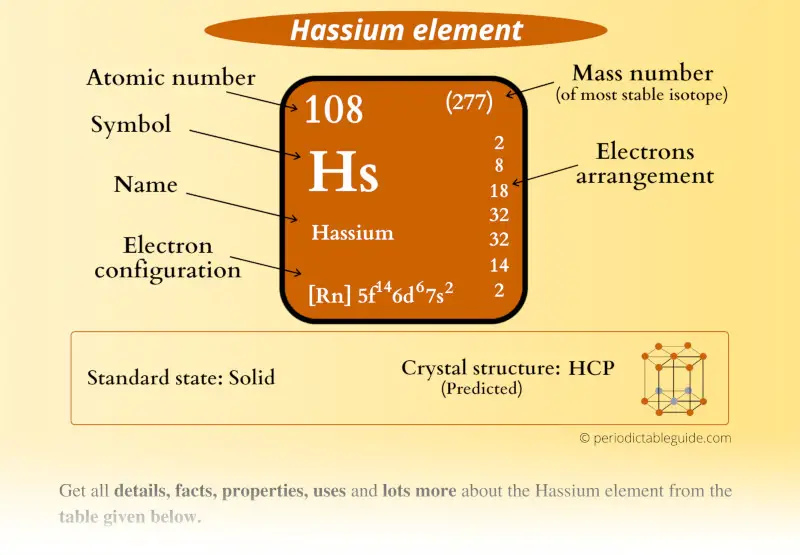
This is a SUPER easy guide on Hassium element.
In fact, the table mentioned below is the perfect information box (Which gives you every single detail about the Hassium element in Periodic table.)
So if you want to know anything about Hassium element, then this guide is for you.
Let’s finish this very quickly.
Hassium Element (Hs) Information
| State (at STP) | Solid (predicted) |
| Position in Periodic table |  Group: 8, Period: 7, Block: d |
| Category |  Transition metals |
| Atomic number or Protons | 108 |
| Neutrons | 157 |
| Electrons | 108 |
| Symbol | Hs |
| Atomic mass of Hassium (most stable isotope) |  277 u |
| Electrons arrangement or Bohr model |  2, 8, 18, 32, 32, 14, 2 |
| Electronic configuration | [Rn] 5f14 6d6 7s2 |
| Crystal structure (predicted) |  HCP (hexagonal close packed) |
| Density (predicted) | 27-29 g/cm3 |
| CAS number | 54037-57-9 |
Hassium in Periodic table
Hassium element is in group 8 and in period 7 of the Periodic table. Hassium is the d-block element and it belongs to transition metals group.
| H | He | ||||||||||||||||
| Li | Be | B | C | N | O | F | Ne | ||||||||||
| Na | Mg | Al | Si | P | S | Cl | Ar | ||||||||||
| K | Ca | Sc | Ti | V | Cr | Mn | Fe | Co | Ni | Cu | Zn | Ga | Ge | As | Se | Br | Kr |
| Rb | Sr | Y | Zr | Nb | Mo | Tc | Ru | Rh | Pd | Ag | Cd | In | Sn | Sb | Te | I | Xe |
| Cs | Ba | La* | Hf | Ta | W | Re | Os | Ir | Pt | Au | Hg | Tl | Pb | Bi | Po | At | Rn |
| Fr | Ra | Ac** | Rf | Db | Sg | Bh | Hs | Mt | Ds | Rg | Cn | Nh | Fl | Mc | Lv | Ts | Og |
| *Ce | Pr | Nd | Pm | Sm | Eu | Gd | Tb | Dy | Ho | Er | Tm | Yb | Lu | ||||
| **Th | Pa | U | Np | Pu | Am | Cm | Bk | Cf | Es | Fm | Md | No | Lr |
←Move to: Bohrium (Bh) element – Periodic Table
→Move to: Meitnerium (Mt) element – Periodic Table
Why is Hassium in Period 7?

Let me ask you a question.
How many shells does a hassium atom have?
It’s 7. Right?
You have already seen the bohr model of hassium atom in the above table.
From the Bohr model, it can be found that the number of orbits or shells in hassium is 7. Hence, as hassium has 7 orbits, it lies in period 7 of the Periodic table.
Why is Hassium in d-block?

Before knowing this reason, first of all I want to ask you a simple question.
How can you determine the blocks-wise position of elements?
The simple answer: The elements will lie in the s, p, d or f block will completely depend upon the subshell in which the last electron will enter.
For example; the electron configuration of hassium is [Rn] 5f14 6d6 7s2.
So the last electron of hassium enters the d-subshell or d-orbital.
Hence, hassium is the d-block element.
5 facts about Hassium
Interesting facts about hassium element are mentioned below.
- Hassium was discovered from “Hesse”, which is a state in Germany. Hence this element was given the name “Hassium”.
- Hassium was discovered by Peter Armbruster, Gottfried Munzenberg and other team members in 1984.
- Hassium is a radioactive element and it is only prepared in laboratories in very low quantities.
- Hassium has around 12 isotopes and all those isotopes are radioactive.
- The isotope 270Hs is expected to have a longest half life of 9 seconds.
Properties of Hassium
The physical and chemical properties of hassium element are mentioned below.
- Hassium is highly radioactive and it has a very short half life (in seconds).
- The predicted phase of Hassium is solid at STP.
- The calculated atomic mass of the most stable isotope of Hassium is 277 u and its estimated density is between 27-29 g/cm3.
- The common oxidation state predicted for hassium is +8, but also shows lower oxidation states like +2, +3, +4 and +6.
- The predicted crystal structure of hassium is HCP (i.e hexagonal close packed).
Uses of Hassium
Hassium is generally used for research work in chemistry. There is no commercial use of hassium due to its expensive production and radioactive nature.
Explore our New Interactive Periodic Table (with Rotating Bohr Models and More)

Details about this Periodic table:
- Access detailed info on all elements: atomic mass, electron configurations, charges, and more.
- View rotating Bohr models for all 118 elements.
- Get a free HD image of the Periodic Table.
Note: For future use, bookmark this Periodic table or visit “PeriodicTableGuide.com”
External resources:
- Hassium – Element information, properties and uses | Periodic Table. (n.d.). Hassium – Element Information, Properties and Uses | Periodic Table. https://www.rsc.org/periodic-table/element/108/hassium
- Hassium – Wikipedia. (2012, October 19). Hassium – Wikipedia. https://en.wikipedia.org/wiki/Hassium
- P. (n.d.). Hassium | Hs (Element) – PubChem. Hassium | Hs (Element) – PubChem. https://pubchem.ncbi.nlm.nih.gov/element/Hassium
- It’s Elemental – The Element Hassium. (n.d.). It’s Elemental – the Element Hassium. https://education.jlab.org/itselemental/ele108.html
